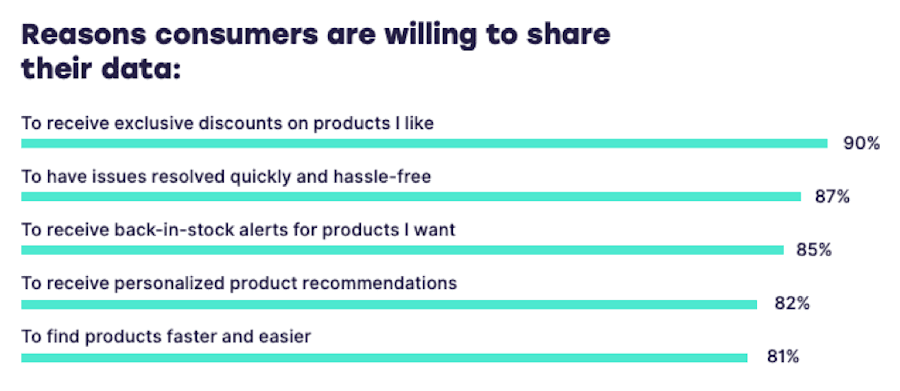What if I told you there was a way to increase ad conversion rates and spend less on ads? It might sound like a pipe dream, but it is possible — with ad personalization.
This article will explore what ad personalization is, the pros and cons, and how to leverage this strategy without being creepy.
If you are a Leadfeeder user, we'll also share how Leedfeeder data can make your ad personalization more effective. Even if you don't use Leadfeeder, there's lots of great info you can use to improve your marketing efforts.
Note: Leadfeeder identifies the companies that visit your site and shows you what pages they visit. Businesses can use that data to inform sales and ad personalization efforts. Get your free, 14-day trial now.
What is ad personalization?
Ad personalization is an advertising strategy that uses personal traits and historical behavior to create more personalized advertising messages. The intent is to deliver more relevant ads to users and increase ad ROI by only targeting the most qualified online users.
There are many ways to personalize ads. For example, you can target users based on:
Geographical area
High buyer intent
Demographics, such as age, income, family status
Historical behavioral patterns (for example, purchase history)
Ad personalization isn't a new strategy — brands have targeted users based on demographic and behavioral information for years. For example, on Facebook, you can target users within a 10-mile radius of your business or those who have liked your posts.
However, what has changed is how users interact with personalized ads and the data businesses can access about their audiences.
Different types of ad personalization
Ad personalization helps brands create hyper-relevant advertisements that stand out. However, there are multiple ways to use ad personalization, and some may be more effective for certain types of businesses.
Here are a few common types to consider using:
Dynamic personalization: Ad copy or images are adjusted based on user behavior or search queries.
Automatically optimized ads: Ad platforms automatically adjust ads to show the most successful ad to more users.
Demographic personalization: Automatically tailor ads based on demographic information, such as location, age, gender, etc.
Direct personalization: Personalized ads that use first-party data about a specific user. For example, when ads use your name or say "you left this item in your cart!"

What are the benefits of ad personalization?
Ad personalization takes ad targeting a step further. Rather than showing ads to users based on where they live or what politicians they follow, ad personalization allows you to better understand who users are and deliver more relevant ads.
Let's look at the benefits of ad personalization in more detail.
Higher ad ROI
In general, personalized ads have a higher ROI. Actually, 70 percent of marketers using advanced personalization are seeing 200% ROI — wild, right?. That's because you can target extremely precise audiences.
Rather than targeting all men over the age of 35 who work in finance, for example, ad personalization lets you target c-suite level employees in finance at enterprise companies with more than 100 employees who are looking for a solution you offer.
And when you aren't wasting money reaching less-qualified prospects, you spend less on each ad.
Consumers prefer personalized ads
In addition to being more effective from a conversion standpoint, consumers actually like personalized ads. In fact, 72 percent of consumers say they will ONLY engage with marketing messages when they are personalized. Why not give people what they want?
Even better, users are willing to share data about themselves to allow businesses to deliver more personalized ads and content.

Image source: Smart Insights
What are the cons of ad personalization?
Despite the benefits, there are some cons of ad personalization. While most of these cons can be mitigated, it's worth paying attention to the drawbacks before you go all-in.
The creep factor
Some consumers are (rightfully) wary about how much data search engines and other companies collect about them. Especially considering how many leaks and data breaches we've seen in recent years.
As a result, some users are creeped out by ads that follow them across devices, even wondering if their phones and tablets are listening into their conversations and using that information to target ads.
Ad personalization that is too personalized can backfire, so use this strategy carefully.
They don't always work
Some users turn off ad personalization, making it harder to reach them. If you rely on personalized ads alone, you may never reach some users who don't like personalized ads.
Plus, if your ad targeting is off, you could see a huge drop in conversions. Say, for example, you think enterprise companies in robotics will like what you have to offer, so you target those users using very personalized ads.
If your ads don't resonate with that group, you get no conversions at all. With a broader ad, you might reach some interested people, even if they don't fit your precise target audience.
Note: Ready to give Leadfeeder a try? Sign up for a free 14-day trial and make ad personalization more effective.
Now that you're here
Leadfeeder is a tool that shows you companies that visit your website. Leadfeeder generates new leads, offers insight on your customers and can help you increase your marketing ROI.
If you liked this blog post, you'll probably love Leadfeeder, too.
Sign up






